History of Pathology
At The Beginning......The History of Pathology
Centuries BC, the Egyptians, Greeks and Romans were investigating disease. In Medieval Europe, early Christians believed that disease was either direct punishment for sin or the result of witchcraft. Diagnosis was superfluous and the basic therapy was prayer, penitence and calling on saints for help.
The first medical diagnoses were made by physicians using their eyes and ears and sometimes the study of urine.
The Age of Enlightenment
During the Eighteenth century, science was held in high esteem and physicians upgraded their social status by becoming more scientific. One of the most important events in medical history was the discovery of the circulation of blood by William Harvey ( 1578-1637) and this marked the beginning of a period of mechanical explanations for digestion, metabolism, respiration and pregnancy.
The invention of the microscope opened the door to the invisible world of disease.
Antonie van Leeuwenhoek. 'The Father of Microbiology', used hand crafted microscopes to observe and report on what he described as animalcules.
Robert Hooke (1636-1703) later used the microscope to document the existence of 'little boxes' or cells.
Thomas Willis ( 1621-1675) pioneered the best qualitative analysis of urine at this time. He was the first to notice the characteristic sweet taste of diabetic urine.
Richard Lower (1631-1691) was the first to perform direct transfusion of blood from one animal to another.
Moving on to the nineteenth century, many scientists were making great strides in bacteriology, microbiology and histology. Improvements in the microscope allowed further exploration of the cellular and microbial worlds
John Snow studied the great London cholera outbreak in 1854, tracing it to the Broad Street Pump.
Louis Pasteur ( 1822-1895) and Robert Koch (1843-1910) provided breakthroughs in bacteriology which gave successful applications of laboratory methods to public hygiene. These two bacteriologists were responsible for the isolation of organisms responsible for major infectious diseases and led public health officials to make a more focused effort against specific disease. Sand filtration of the water supply (1890\'s) proved effective in preventing typhoid. Pasteurisation of milk cut infant mortality dramatically. Antiseptic surgery reduced mortality from injuries and operations and increased the range of surgical work.
The emergence of the hospital laboratory
By the mi-1800s, lab tests had been introduced to detect tuberculosis, cholera, typhoid and diphtheria and the first hospital laboratory in Britain was set up at Guys Hospital.
However, the greatest source of medical knowledge in the nineteenth century was by post mortem examination and dissection. For this reason, Northampton Infirmary had a \'dead house\' on site and reports in 1886 show that a new mortuary/dissecting room was built in the hospital grounds at a cost of £225.
Hospital reports in 1901 state that after the construction of the two pavilion blocks jutting out southwards from the original infirmary building and built with the money from the Queen Victoria Memorial Fund, some of the vacated rooms at the front of the infirmary were to be reconfigured to include a pathological museum, a microscope room and a laboratory for bacteriological investigations. This pathology laboratory was fitted up at a cost of £60 and was regarded as necessary, along with an Ophthalmoscope Room and other departments, in the investigation of disease.
Northampton Royal Victoria Provident Dispensary. Albion Street.
This was built to mark the visit of Queen Victoria to Northampton in 1844. The funds devoted to the purpose were originally intended to provide a roast beef and plum pudding dinner for the poor of the town.
In the 1914 Ministry of Health Report, it shows that a Clinical T.B. Officer was appointed in June 1913 and shortly afterwards arrangements were begun for the establishment of a T.B. dispensary. Convenient premises for this were obtained in Hazelwood Road on a seven year lease. Part of the dispensary consisted of a bacteriology laboratory, mainly for T.B. work, but it was found possible to make use of it for bacteriological work in other directions. Work started on this in June 1914.
Not to be outdone, it shows that in the Hospital Medical Board Minute Book (Feb.6th 1914) that the Medical Board recommended to the Board of Management \'that a small committee be appointed to enquire into the possibility of the appointment of a paid pathologist and bacteriologist to do pathological and bacteriological work of the hospital for the Town and County.\'
Hospital Medical Board Minute book Oct. 30/16
Resolved: That a primary necessity for the carrying out of the Government Scheme for the treatment of V.D. is the building of a properly equipped pathology department under a skilled pathologist. We estimate the cost of the building and equipment at £2,000.
N.B. Roughly 5% of all the men enlisted in Britain\'s armies during the war became infected with VD and five times more likely to be hospitalised than those suffering from Trench Foot/frostbite.
The quest to build a purpose built pathology laboratory was hampered by the outbreak of War.
The Hospital Board pursued their quest to build and the Medical Board Minute book (Nov 2/17) shows:
Reasons for establishment of Pathological Laboratory to be given to the Chairman of Board and Management who is to interview the Minister of Munitions with regard to permission to build:
- No laboratory between London and Birmingham.
- Money promised if work proceeded with at once so that soldiers may benefit.
- Builders have materials in hand.
- Town and County authorities have to send specimens away and are anxious to have a local laboratory.
- Venereal Clinic makes laboratory essential.
- Faeces of invalid soldiers have to be sent to Cambridge.
- No local means of making vaccines.
However, the Ministry of Munitions of War refused permission to build the laboratory and it was not until 31st December 1918, that a building licence was granted. The Government removed restrictions on building, largely to pave the way towards realisation of a 5,000 house building scheme.
The anonymous donor increased his offer to £3,000. Dr Browning, the pathologist at the Middlesex Hospital, advised about the design of the laboratory. The siting of the laboratory was to be on ground at the east side of the administration block where it would be hidden from observation from the Billing Road.

G.T.Hawkins
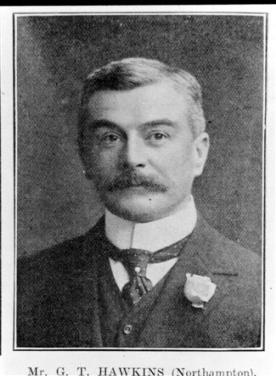
( Photo courtesy of Mr Deacon from the book 'St Crispin's Men')
The anonymous donor turned out to be Mr G.T.Hawkins , a well-known boot and shoe manufacturer and a large employer of labour who had a high reputation as a considerate and generous employer, was known to be socially awkward, taking little or no part in public life but always ready to help. His gift of over £3,000 to build and equip the laboratory that was to be named after him, was the largest ever given to the hospital by one person up to that time. However, by the time the laboratory opened on the 1st April, 1920, delayed by difficulty in obtaining materials after the war, its cost had risen to £6,557 17s, which was entirely defrayed by Mr G.T.Hawkins.
The Hawkins Laboratory
On the 14th October, 1919, Dr Eric Hemmingway Shaw was appointed as pathologist and paid £750 p.a. On the 27th January, 1920 at the request of Dr Shaw, Mr F.S.Drury was appointed assistant in the laboratory. He was then 31 years of age and had worked with Dr Shaw at Cambridge. His salary was to be £5 a week.
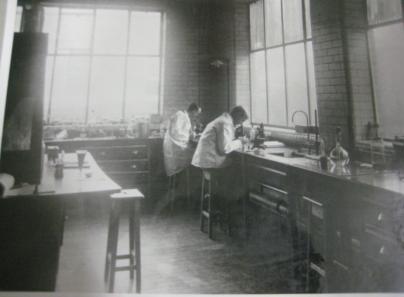
The man sitting at the microscope wearing a short white coat Is Dr Shaw and the man behind him is Mr Drury.
Dr E.H. Shaw M.D., B.S.(Durham), D.P.H.(Cantab)
Insulin was discovered and isolated in 1922 and by 1923 Dr Shaw was faced with a quickly increasing demand for blood sugar analysis and in fact he played a great part in the treatment of diabetic patients.
In 1925 it was reported that Dr Shaw had obtained a licence to inoculate guinea pigs, which was a diagnostic procedure for the detection of tuberculosis.
He was made an honorary consultant pathologist in 1940 and remained working at the hospital until his retirement in 1952.
From the Archives
Annual Report 1921
During the past year the Pathology Laboratory, which G.T.Hawkins so generously built and equipped for the Hospital, has been of enormous assistance in the diagnosis and treatment of difficult cases, not only to the doctors in the hospital but to private practitioners, as well as to the Public Health Authorities in Northampton and the neighbourhood. This is strikingly shown by the fact that during the year no fewer than 4,811 specimens were received and examined by the Pathologist and his assistant.
Annual Report 1923
'The number of specimens examined during the year amounted to 4,827. The amount of work received from private practitioners has increased but the facilities provided by the laboratory are not yet used as much by them as they might be. As there has been no epidemic of Diphtheria this year, the number of swabs sent for examination has diminished. New work has been undertaken in regard to treatment of diabetic patients with insulin. The amount of work done for the hospital has increased, and actually occupies the greater part of the activities of the laboratory. The financial side shows a distinct improvement, the income exceeded the expenditure by £537 15s 1d.'
Annual Report 1940
For some time there has been in the County a demand for a more extensive pathology service which the hospital, with its limited staff was unable to give, but the Board has been approached by the Ministry of Health asking for co-operation in reorganising laboratory services for the area and in arranging for the hospital to become a pathological centre of public health work. This alteration would entail the services of a full-time Pathologist.
If the hospital should appoint such a person, the Medical Research Council would appoint and pay salaries of a Bacteriologist and an extra technician to carry out Public Health work in the laboratory and also make a block grant towards the cost of work and equipment. The hospital would have the benefit of these two officers in connection with its ordinary work.
In view of this offer, the Board appointed a full-time Pathologist, Dr E.S. Duthie PhD and made Dr E.H.Shaw an Honorary Consultant Pathologist and the Emergency Public Health Laboratory was set up in the Hawkins Laboratory under \'WW11 special measures.
Laboratory assistants
Laboratory assistants entered their profession as \'lab boys\', a name that stuck with pathology staff well into the second half of the 20th century. They started off by washing glassware, dusting shelves, preparing bacteria growing media, collecting and testing urine, making swabs, looking after the animals used in tests and often became indispensible assistants working alongside the pathologists in their research. Later, unqualified assistants began appearing more routinely in laboratories and after WW11, normal training courses and recognised qualifications were developed.
Before WW11, individual scientists trained their technicians to do the precise work they required. Increasingly, technicians recognised the limitations of this training and many found night classes to attend to improve their skills. Gradually this led to colleges providing tailored courses and technicians were allowed to attend them on a day release basis. Technicians from Northampton attended Tresham Technical College in Kettering, and then later HNC courses were done on block release in Bristol. This has now progressed to students entering the profession straight from university with biomedical degrees.
( Tresham College, Kettering 1960\'s)
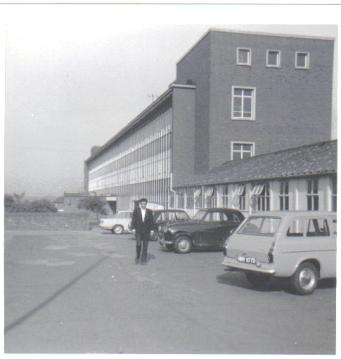
As medicine became more scientific and scientists moved into hospitals, they took to wearing the same white coats as doctors, partly for efficiency and partly to give themselves added status in the medical community, where they were seen as second class. The lab coat as a status symbol then moved into other areas of science.
The Hawkins Lab in the 1960's, before closure
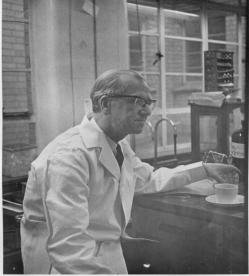
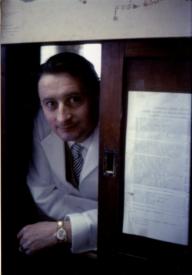
Stan Clarke - Chief Technician(Left) Maurice Peel - Senior Technician(Right)
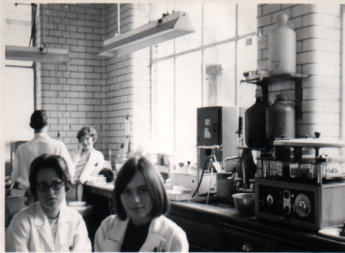
Haematology
(More photos from the Hawkins Lab)
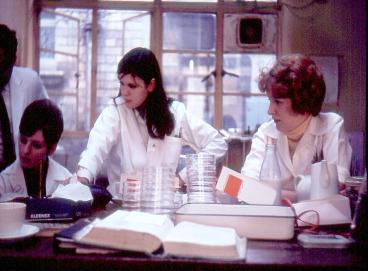
Microbiology
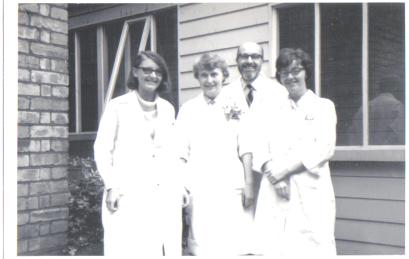
Histology staff, showing Charles Clark ( who took over as Chief Technician when his brother Stan died)
As the laboratory became busier, the testing more academic and proficient, a greater number of technicians were needed, space became an issue, even though Public Health had already moved into new premises, and so a larger laboratory had to be built.
A new laboratory for the hospital
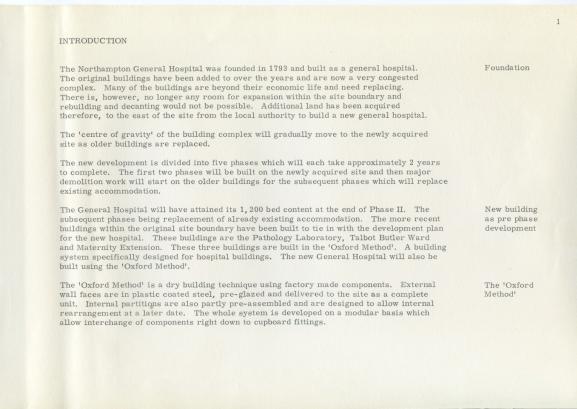
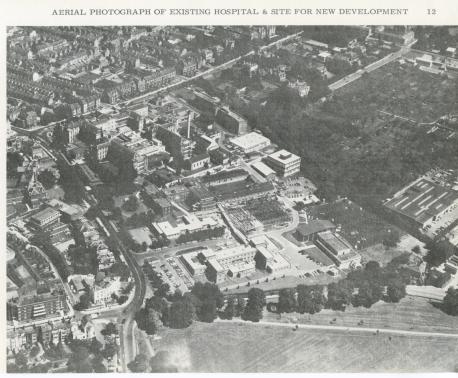
....and so work begins......
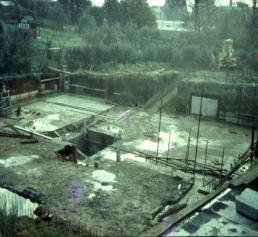
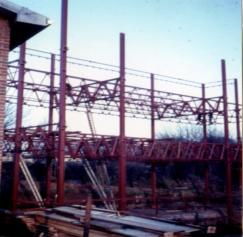

May 8th 1968 the New Laboratory was opened
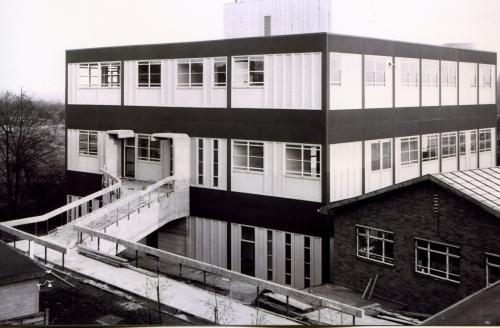
The laboratory was officially opened by Dame Isobel Bryce, Chairman of the Oxford Regional Board.
Gillie Brittain, being the youngest member of staff, presented her with a bouquet of flowers.
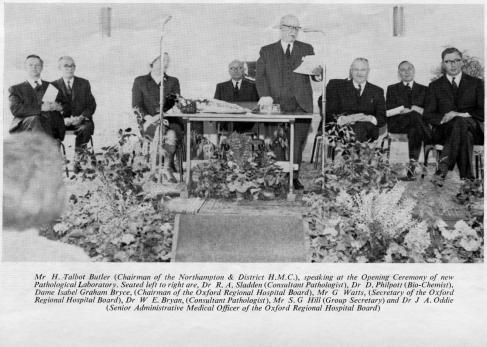
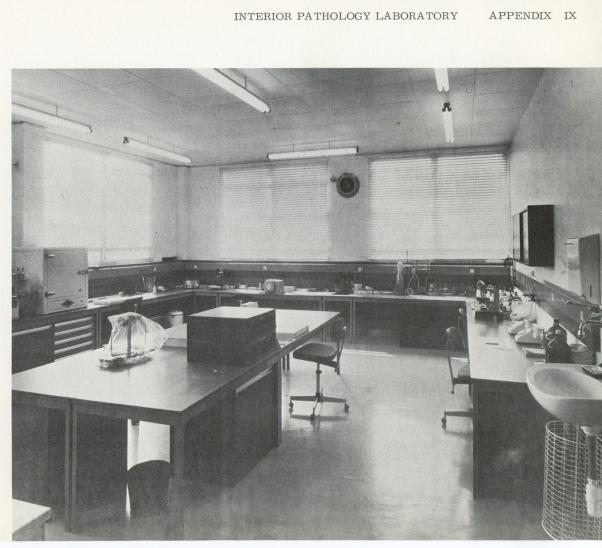
Histology
The new laboratory consisted of:
Top Floor: Post Mortem room, Histology, Cytology, Library and consultants rooms.
1st floor: General Office, Reception, Blood Transfusion, Haematology and Biochemistry.
Ground Floor: Mortuary, Bacteriology, Media Rooms, Wash up rooms, and Staff Rooms.
Basement: Storerooms and 'Specials' labs.
The Wheel of Change Moves On.....
1970's
Public Health absorbed by Bacteriology, now known as Microbiology.
Biochemistry moved into the vacated building.
1980's
The Hospital Street, which attached the old part of the hospital to the new one, allowed the laboratory to be accessed in the dry and warm, which was much appreciated by all.
Blood Transfusion move out and into rooms on the opposite side of the corridor, next to the Haematology Clinic.
Once again, the Pathology laboratory seemed to be hidden out of sight.
The view below is the one seen from the hospital street now.
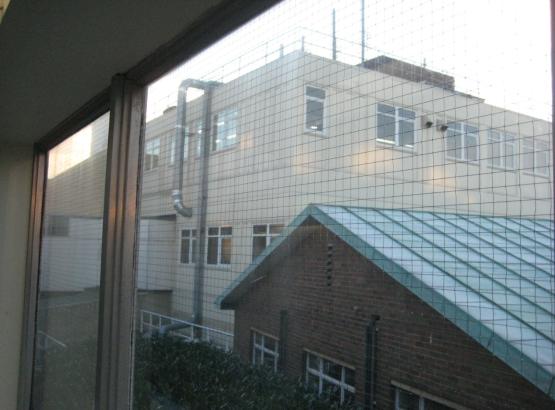
Phase 2: Cellular Pathology
1985
A new building to house the mortuary, post mortem rooms, offices and histology and cytology labs was built, sited to the south of the main pathology building, at a cost of £2.5 million
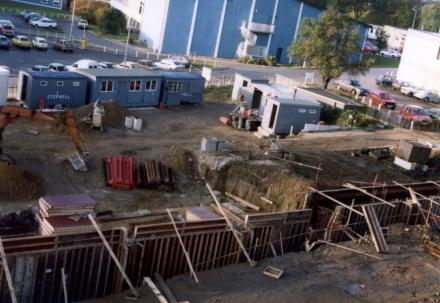
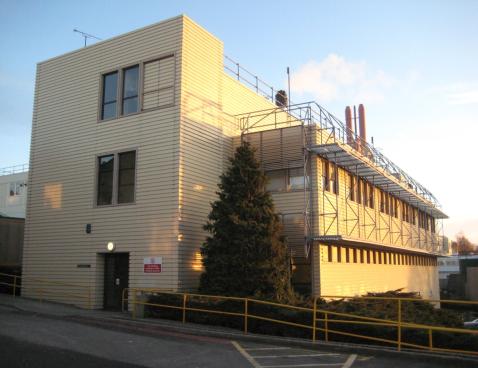
21st Century Laboratory
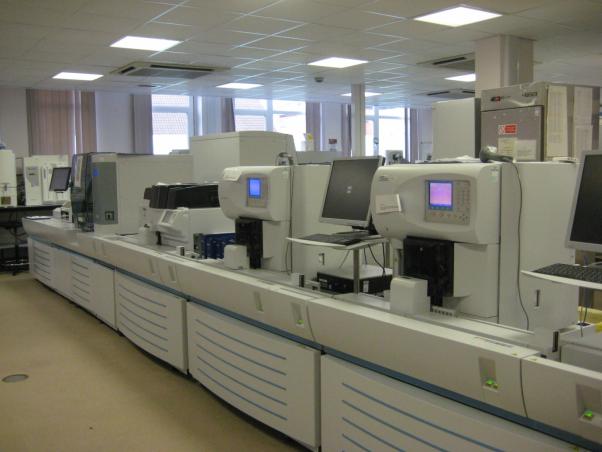
Blood sciences (these machines do Haematology and Biochemistry blood testing)
Machines are taking over!
Pathologists
E.H.Shaw, M.D., B.S.( Durham), D.P.H.( Cantab)
Appointed Pathologist in 1919. Retired 1952
E.S.Duthie, Ph.D.( Dublin), M.Sc., M.B.Ch.B., B.A.O., D.P.H.
Appointed pathologist 1941. Resigned 1943
Leslie Hoyle, M.B., Ch.B( Leeds)
Appointed bacteriologist to Public Health 1941. Died 1972
H.I.Coomb, M.A.,BSc.( Oxford), Ph.D.( Camb.) M.D.( Havard), M.R.C.S., L.R.C.P.
Pathologist from 1943 to 1944
R.M.Heggie, M.B., Ch.B.(Glasgow), B.Sc.
Pathologist 1945 to 1958
W.E.Bryan, M.B.,B.S.(London), M.R.C.S., L.R.C.P.
Appointed morbid anatomist and deputy pathologist 1947. Died 1971
D.Philpott, M.Sc., Ph.D.(Wales), R.R.I.C., D.I.P.Ed. (Bristol)
Appointed bio-chemist 1947. Retired 1968
In the 1970's, as the laboratory grew in size, each discipline was appointed its own consultant.
Interesting Facts
Anthrax
Northampton, being a boot and shoe town, saw quite a lot of cutaneous anthrax. It was an occupational hazard amongst the leather workers and boils were found on necks, arms, hands or anywhere the body was touched when carrying or handling the animal hides.
Blood
To make various media for growing bacteria, buckets of blood and condemned meat were fetched from the local abattoirs.
Health and Safety
The Health and safety at Work Act 1974 saw great changes in the laboratory.
Beverages and food were no longer allowed to be eaten at the bench while working, nor food kept in laboratory fridges
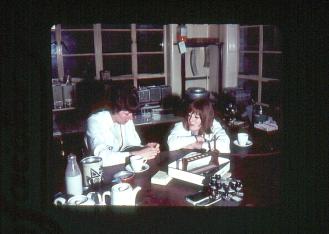
Smoking in laboratories was also banned and not before time as numerous flammable liquids were present. Many an eyebrow disappeared when a a smoker flicked ash into a sink recently used to clean pipettes with meths and ether. Boom!
Influenza
Dr Hoyle's research into influenza made Northampton\'s Public Health Department one of the two reference laboratories in England and was deemed most important during WW2.
Service to Northamptonshire Hospitals
Creaton and Harborough Road hospitals used to have small laboratories manned by technicians. These were closed in the 1960's and so technicians used taxis to visit Creaton, Harborough Road, Welford Road, St Edmunds, Manfield and the two Pitsford Hospitals when requested to take blood and collect samples. Technicians also attended Wolverton Clinic to take blood and perform tests on Warfarin patients.
Phlebotomists
Gradually technicians were relieved of blood collecting duties on the wards, in outpatient laboratories and other hospitals when phlebotomists were started to be employed in the 1970's. The first 'blood collecting ladies' were retired nurses.
Robins
When the earthmovers appeared to flatten the allotments and hedges in preparation for building the new part of the hospital, a family of displaced robins made a nest in the autoclave room on the ground floor, entering through a widow that was locked open to allow ventilation tubing to poke through. The robin family were so tame they flew down the corridor to the tea room to eat crumbs left on the tables. This was the laboratory's claim to fame as it was mentioned in the local paper.
Social Life
The Path. Lab was a very social department, being peopled by an influx of young students when the new laboratory was built and an increase of staff needed. Swimming, tennis, and rounders in the park were general pastimes but we also had a hockey team and played other hospital departments from NGH and Kettering. Northampton's carnival was the highlight on the social calendar.
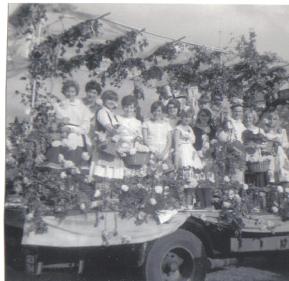
References
A History of Northampton General Hospital 1743 to 1948.
F.F.Waddy
Last of the 'lab-boys'.
Professor Tilli Tansey
A brief history of medical diagnosis and the birth of the clinical laboratory.
Darlene Berger
The British Army's fight against Venereal disease in the 'Heroic Age of Prostitution'.
Richard Marshall
Many thanks to staff of Pathology who gave time to share memories and those who supplied photographs.
Namely, Sue Macdonald, Tony Perrett, Richard Halton, Trevor Ward, Des Henman, Jim Collins, David Gauld, Gillian Brett, Rosemary Shaw, Alan Sharp, Roger Clayton, Maurice Peel, Madeleine Clarkson, Patricia Walden, Stephen Miles, Derek Millard, Harold Neal, Clare Wood, NGH historical archive staff....and everyone else who supported me. Julia Corps
Return to Our History main menu.